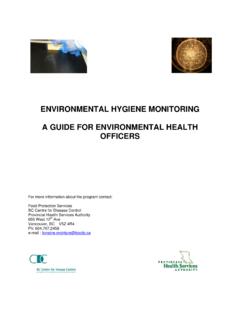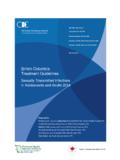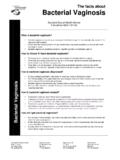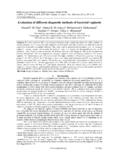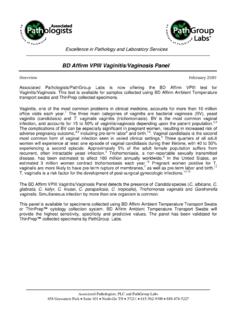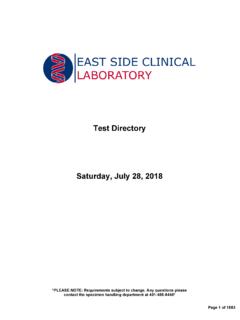Transcription of PELVIC INFLAMMATORY DISEASE (PID)
1 BCCDC Non-certified Practice Decision Support Tool PELVIC INFLAMMATORY DISEASE (PID) BCCDC Clinical Prevention Services Reproductive Health Decision Support Tool Non Certified Practice PID - March 2015 1 PELVIC INFLAMMATORY DISEASE (PID) DEFINITION PELVIC INFLAMMATORY DISEASE (PID) is an infection of the female upper genital tract that involves any combination of the uterus, endometrium, ovaries, fallopian tubes, PELVIC peritoneum and adjacent tissues. PID consists of ascending infection from the lower to upper genital tract. RNs (including certified practice RNs) must refer to a physician or nurse practitioner (NP) for all clients who present with suspected PID as defined by PELVIC tenderness and lower abdominal pain during the bimanual exam. POTENTIAL CAUSES Most cases of PID can be categorized as sexually transmitted or endogenous and are associated with more than one organism or condition including: Neisseria gonorrhoeae (GC) Chlamydia trachomatis (CT) Trichomonas vaginalis Mycoplasma genitalium Mycoplasma hominis Ureaplasma urealyticum Bacterial vaginosis (BV) BCCDC Non-certified Practice Decision Support Tool PELVIC INFLAMMATORY DISEASE (PID) BCCDC Clinical Prevention Services Reproductive Health Decision Support Tool Non Certified Practice PID - March 2015 2 PREDISPOSING RISK FACTORS sexual contact history of STI procedures involving the upper female genital tract including.
2 O dilatation & curettage (D&C) o recent intrauterine device (IUD) insertion o therapeutic abortion (T/A) TYPICAL FINDINGS Sexual Health History sexual contact recent IUD insertion procedure involving the upper genital tract Physical Assessment Cardinal Signs lower abdominal pain usually bilateral abnormal bimanual PELVIC examination that includes one or a combination of the following findings: o adenexal tenderness o fundal tenderness o cervical motion tenderness BCCDC Non-certified Practice Decision Support Tool PELVIC INFLAMMATORY DISEASE (PID) BCCDC Clinical Prevention Services Reproductive Health Decision Support Tool Non Certified Practice PID - March 2015 3 Additional Signs & Symptoms fever >38 C dyspareunia abnormal vaginal bleeding or spotting abnormal vaginal discharge urinary frequency PELVIC pain nausea or vomiting low back pain Special Considerations It is important to rule out other potential causes of lower abdominal pain including ectopic pregnancy, ovarian cysts, and gastrointestinal causes including appendicitis.
3 Diagnostic Tests cervical or vaginal swab for nucleic acid amplification test (NAAT) for GC and CT AND cervical swab for GC culture & sensitivity (C&S) AND urine pregnancy test AND vaginal swabs for Trichomonas vaginalis, yeast and BV KOH whiff test vaginal pH AND bimanual exam for tenderness In addition to the diagnostic tests above, offer clients routine STI and HIV screening. BCCDC Non-certified Practice Decision Support Tool PELVIC INFLAMMATORY DISEASE (PID) BCCDC Clinical Prevention Services Reproductive Health Decision Support Tool Non Certified Practice PID - March 2015 4 CLINICAL EVALUATION Immediately refer all clients who present with suspected PID to a physician or NP for immediate assessment and treatment to avoid complications. Note: When indicated, IUD removal is managed by a physician or NP.
4 For moderate PID, IUD removal during treatment is not necessary unless there is no clinical improvement 72 hours after the onset of recommended antibiotic treatment. MANAGEMENT AND INTERVENTIONS Goals of Treatment preserve fertility treat infection alleviate symptoms prevent further complications prevent spread of infection Criteria for Potential Hospitalization The following criteria may indicate the need for hospitalization or parenteral therapy: surgical emergencies, such as appendicitis or ectopic pregnancy pregnancy client cannot tolerate oral treatments client is under the age of 19 severe abdominal pain client has abdominal guarding, rigidity, or rebound tenderness severe nausea, vomiting, or a fever > C underlying illnesses such as diabetes, HIV or active hepatitis infection concerns with the client s ability to complete oral antibiotic therapy BCCDC Non-certified Practice Decision Support Tool PELVIC INFLAMMATORY DISEASE (PID)
5 BCCDC Clinical Prevention Services Reproductive Health Decision Support Tool Non Certified Practice PID - March 2015 5 TREATMENT OF CHOICE - USE ONLY IN CONSULTATION WITH A PHYSICIAN OR NP PID WITHOUT Bacterial Vaginosis PID WITH Bacterial Vaginosis NOTES First Choice cefixime 800 mg PO in a single dose and doxycycline 100 mg PO bid for 10 days OR ceftriaxone 250 mg IM in a single dose and doxycycline 100 mg PO bid for 10 days First Choice cefixime 800 mg PO in a single dose and doxycycline 100 mg PO bid for 10 days and metronidazole 500 mg PO bid for 10 days OR ceftriaxone 250 mg IM in a single dose and doxycycline 100 mg PO bid for 10 days and metronidazole 500 mg PO bid for 10 days 1. Treatment for PID covers for both gonorrhea and Chlamydia infections. 2. DO NOT USE ceftriaxone or cefixime if history of allergy to cephalosporins or a history of anaphylaxis or immediate reaction to penicillin.
6 3. DO NOT USE doxycycline if allergic to tetracycline. 4. DO NOT USE azithromycin if history of allergy to macrolides. 5. DO NOT USE lidocaine if history of allergy to lidocaine or other local anaesthetics. Use cefixime PO as alternate treatment. 6. The preferred diluent for ceftriaxone IM is ml lidocaine 1% (without epinephrine) to minimize discomfort. 7. For intramuscular injections (IM) of ceftriaxone the ventrogluteal site is preferred. (See ) 8. Use of doxycycline as the first choice is preferable in the treatment of PELVIC INFLAMMATORY DISEASE due to its increased effectiveness for the co-treatment of Chlamydia. BCCDC Non-certified Practice Decision Support Tool PELVIC INFLAMMATORY DISEASE (PID) BCCDC Clinical Prevention Services Reproductive Health Decision Support Tool Non Certified Practice PID - March 2015 6 continued from previous page Second Choice cefixime 800 mg PO in a single dose and azithromycin 1 gm PO in a single dose and 1 gm PO in a single dose in 1 week (for a total of 2 doses given 7 days apart) OR ceftriaxone 250 mg IM in a single dose and azithromycin 1 gm PO in a single dose and 1 gm PO in a single dose in 1 week (for a total of 2 doses given 7 days apart)
7 Continued from previous page Second Choice cefixime 800 mg PO in a single dose and azithromycin 1 gm PO in a single dose and 1 gm PO in a single dose in 1 week (for a total of 2 doses given 7 days apart) and metronidazole 500 mg PO bid for 10 days OR ceftriaxone 250 mg IM in a single dose and azithromycin 1 gm PO in a single dose and 1 gm PO in a single dose in 1 week (for a total of 2 doses given 7 days apart) and metronidazole 500 mg PO bid for 10 days 9. Advise the client to remain in the clinic for at least 15 minutes post IM injection in case of anaphylactic reaction to treatment. Provide anaphylaxis treatment as required, using the BCCDC Immunization Manual- Section V- Management of Anaphylaxis in a Non-Hospital Setting. 10. If serious allergic reaction develops including difficulty breathing, severe itchiness, have the client inform clinic staff immediately.
8 If symptoms develop after leaving the clinic, advise the client to seek immediate emergency care. 11. Advise client about the potential for the side effects of pain, redness and swelling at the injection site or diarrhea. If any of these effects persist or worsen, advise to contact health care provider 12. Azithromycin is associated with gastrointestinal adverse effects. Taking the medication with food or administering a prophylactic antiemetic may minimize adverse effects 13. See BCCDC Medication Information Sheets for further medication reconciliation and client information. BCCDC Non-certified Practice Decision Support Tool PELVIC INFLAMMATORY DISEASE (PID) BCCDC Clinical Prevention Services Reproductive Health Decision Support Tool Non Certified Practice PID - March 2015 7 PREGNANT OR BREASTFEEDING Refer all pregnant or breastfeeding clients to a physician or NP.
9 PARTNER COUNSELLING AND REFERRAL Counsel clients receiving treatment for PID to notify sexual contacts within the previous 60 days (or the last sexual contact) that they require testing and treatment to cover for Chlamydia and gonorrhea infection. See the CRNBC Treatment of STI Contacts DST. Unless the client tests positive for a reportable STI ( , Chlamydia, gonorrhea), the client completes partner notification. MONITORING AND FOLLOW-UP recommend the client return for re-assessment or seek medical care if symptoms have not resolved by 3 -7 days after the onset of treatment advise the client to seek urgent medical care if symptoms worsen refer to a physician or NP at reassessment if the client s symptoms are unresolved if test results are positive for gonorrhea and/or Chlamydia, refer to appropriate DST for follow-up POTENTIAL COMPLICATIONS Fitz-Hugh-Curtis syndrome tubo-ovarian abcess ectopic pregnancy chronic PELVIC pain tubal factor infertility recurrent PID BCCDC Non-certified Practice Decision Support Tool PELVIC INFLAMMATORY DISEASE (PID)
10 BCCDC Clinical Prevention Services Reproductive Health Decision Support Tool Non Certified Practice PID - March 2015 8 CLIENT EDUCATION Counsel client: to return or seek medical care for reassessment of PELVIC tenderness if symptoms have not resolved by 3-7 days after starting treatment. to seek urgent medical care if symptoms worsen. regarding the appropriate use of medications (dosage, side effects, and need for re-treatment if dosage not completed). to avoid sexual contact until the client and their partner(s) have completed screening and treatment. to inform all sexual contacts within the last 60 days (or the last sexual contact if no contacts in previous 60 days) that they require testing and treatment. regarding harm reduction measures ( , condom use). regarding the complications from untreated PID.


